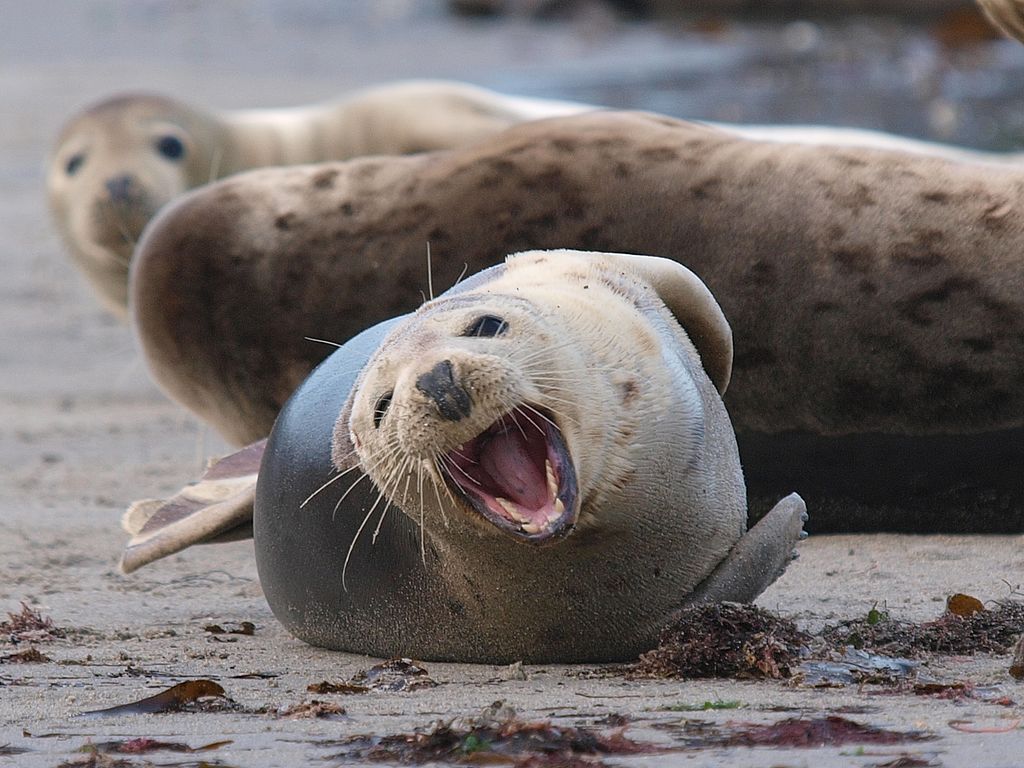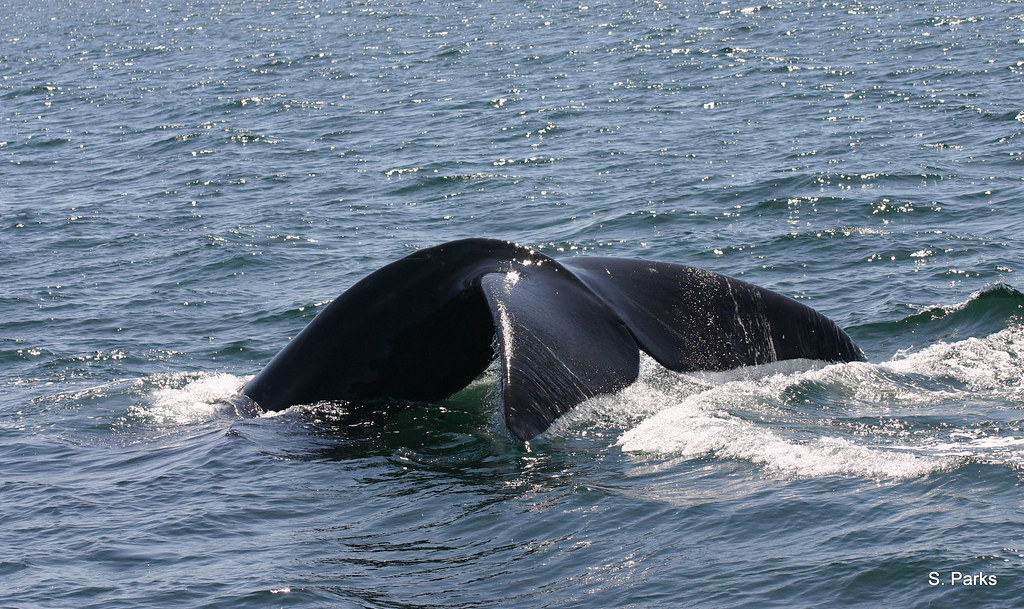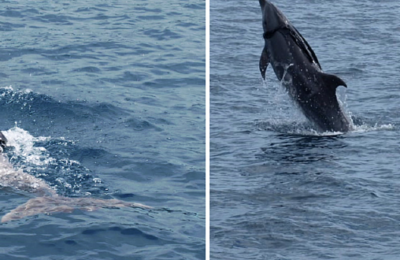Content warning: The following post contains some graphic images of deceased animals, as well as graphic photos taken during necropsies (i.e. animal autopsies). Reader discretion is advised.
Westphal, L., Klemens, L., Reif, F., van Neer, A. & Daehne, M. (2023). First evidence of grey seal predation on marine mammals in the German Baltic Sea. Journal of Sea Research. 102350. 10.1016/j.seares.2023.102350. DOI: 10.1016/j.seares.2023.102350
This is the first documentation of a grey seal (Halichoerus grypsus grypsus) predation on a harbour seal (Phoca vitulina) in the German Baltic Sea. In August 2021 a deceased juvenile male harbour seal was recovered in Darsser Ort, in Germany with distinct grey seal predation markers on its body. According to scientist van Neer such lesions are characterised by a “corkscrew” helical and cut-like wound with smooth and already partly healed edges.
In the past, Baltic grey seals had to face many challenges and were almost eradicated in the 1980s. Human greed for fur, blubber, and meat, as well as reckless dumping of marine pollutants, namely PCBs (polychlorinated biphenyls) and DDTs (dichlorodiphenyltrichloroethane) depleted a perfectly healthy population of a hundred thousand grey seal individuals, at the beginning of the twentieth century to only three thousand, by the late 1980s. PCBs and DDTs resulted in reduced fertility and reproduction rates, bringing about what today is known as the Baltic Seal Disease Complex (BSDC).
Fortunately, conservation efforts were later implemented banning both seal hunting and marine dumping in the North and Baltic Sea. Monitoring counts in 2021 by HELCOM, the Baltic Marine Environment Protection Commission recorded a rebound of over forty thousand grey seal individuals. Three thousand alone in the southern Baltic Sea and eight thousand in the adjacent North Sea.
First occurrences of grey seal predation on marine mammals, in particular harbour porpoises had been first documented off the coast of the Netherlands, Belgium, and Great Britain in 2012 and 2015. In 2013, Helgoland, a small archipelago in the North Sea also announced its first grey seal predation on a harbour porpoise, followed by an additional two grey seal cannibalism incidents in 2016 and 2019.
This study discovered characteristic puncture wounds (Figure 1f), significant soft tissue missing (Figure 1e), reduced blubber thickness, uneven blubber tissue surface, a helical lesion in head area extending from the end of the lower jaw to the neck region (Figure 1bc), rake marks (Figure 1g), both shoulder blades being exposed and a split off thorax (Figure 1d), as well as cut-like lesions (Figure 1a-c). The additional indicator namely the skeletal trauma of the skull and lower jaw could not be seen and therefore was noted absent.
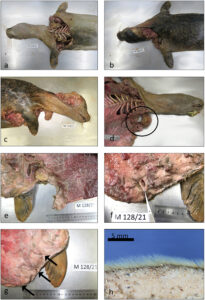
Beached marine mammals are often exposed to red fox scavenging, in which the wound is ragged, the hair shafts are defected, and soft skin tissue is missing. This harbour seal showed no signs of fox predation. In total eight out of twelve markers were present, which clearly suggests grey seal predation (Table 1).
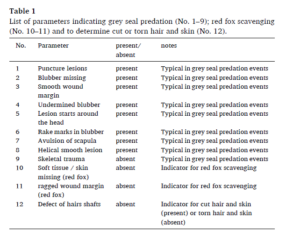
This study also highlights other grey seal predation incidences in Germany. In 2020, a harbour porpoise (Figure 2a) was sighted in Northwestern Mecklenburg showing signs of skeletal trauma in the skull, smooth wound margins and cut-like lesions with a significant amount of tissue missing. Postmortem examination also concluded that fox scavenging was visible on this porpoise. Also, some beached porpoise skin recovered in 2019 and 2020 was the result of grey seal predation (Figure 2b-d).
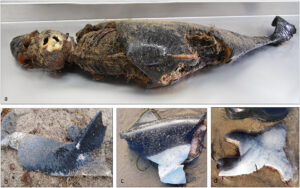
Grey seals are also known to interact with each other causing fatal injuries. Another adult male grey seal carcass off the island “Ruegen” had two grey seal vibrissae in its stomach indicating a possible intraspecific interaction. In May 2022 a juvenile carcass was either involved in a cannibalistic predation attempt or combat at a haul-out or pupping site.
Clearly grey seals have presented themselves as opportunistic predators. In the past such helical lesions were misinterpreted as ship-strike events. Having such guidelines, as this one by van Neer will ensure more accurate data collection in future.
Cover image: Grey seal on beach (Wikipedia: Christian Rosenbaum, 2011)
I have a master’s degree in marine biology, ecology, and behavioural biology obtained from the University of Vienna. Since I can remember I wanted to become a marine biologist, despite growing up in a country without an ocean, but I guess my South African roots just kept on pushing to make this dream come true. After graduation I spent a year in Australia and assisted several NGOs with marine educational talks and citizen science programmes. Here I had the privilege of observing humpback whales on their annual migration passed the eastern coast of Australia, and participating in seagrass and rockpool monitoring activities. With a heavy heart I left Australia, but soon after obtained a position as a marine educator at Malta National Aquarium. Today I am based in Germany exploring marine critters in the North and Baltic Sea and if I am not too busy, you’ll find me diving in the Red Sea, blogging on my Facebook page, swimming, running, reading, and meditating.

